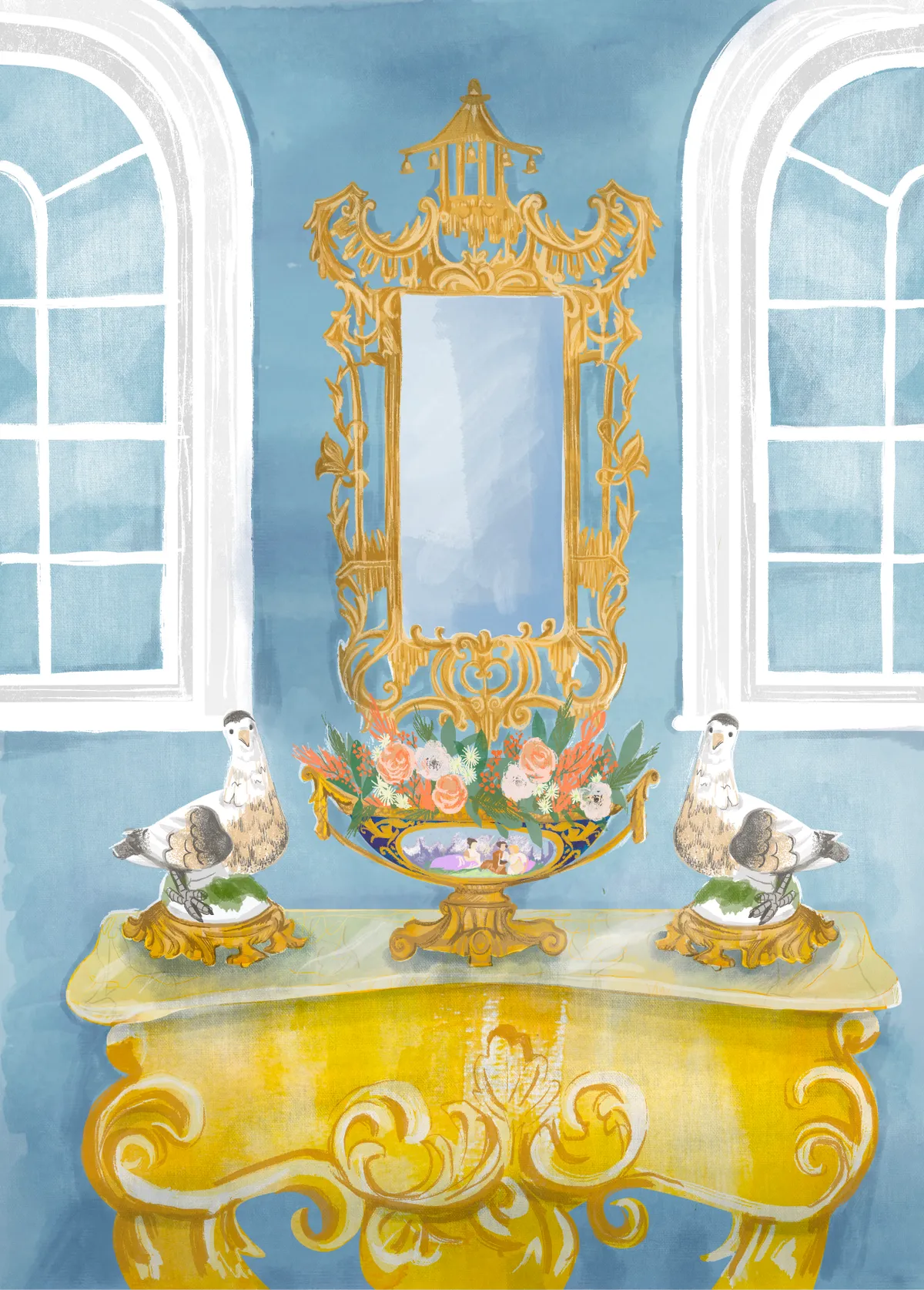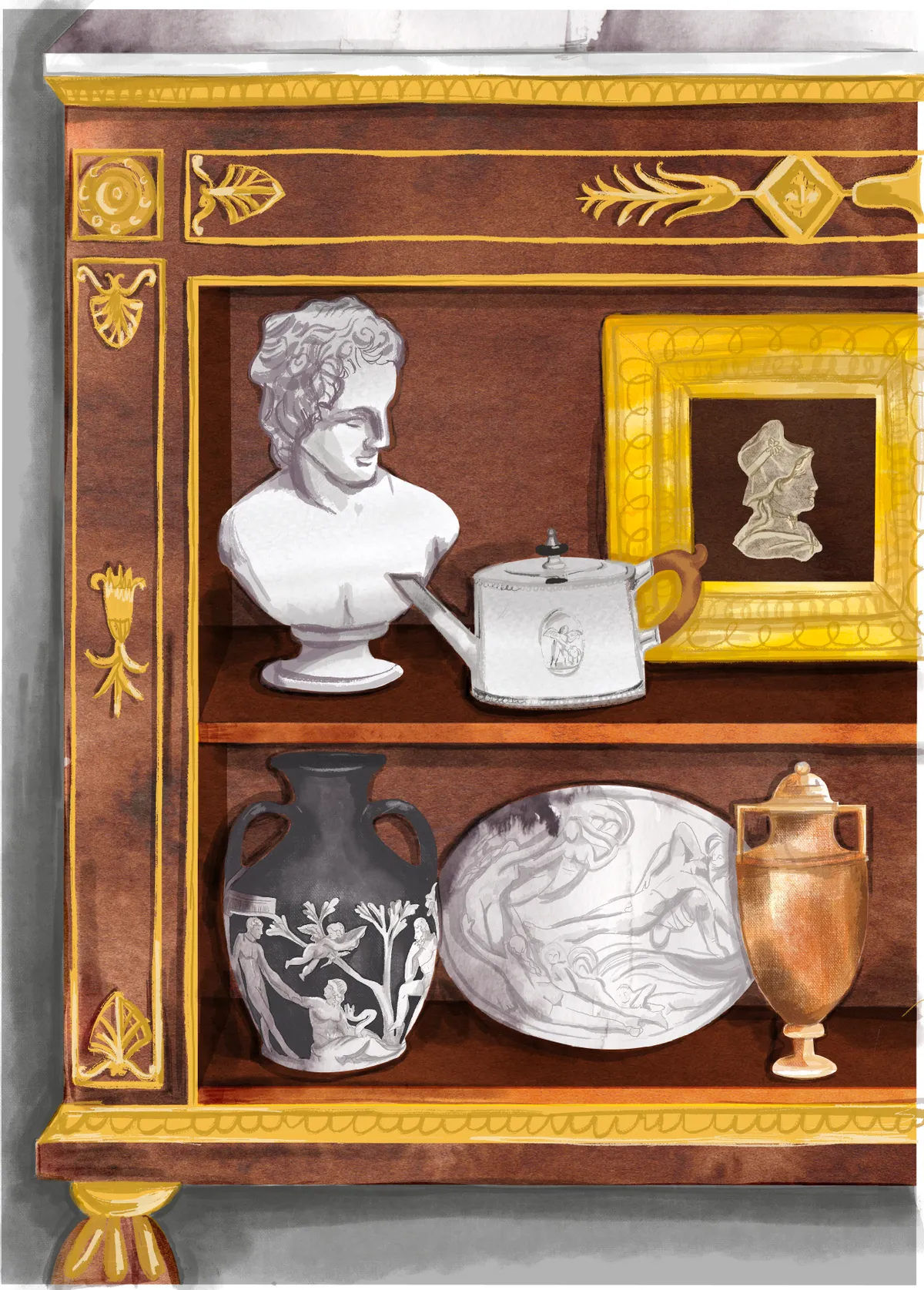From vast, elegant townhouses to shapely brown furniture, the Georgian era was a golden age of design and architecture. But if we dig a little deeper, we find that the craftsmen of the day drew their inspirationfrom all over the world, and often looked to the exotic or the ancient as the basis for their designs. Here we explore the ground-breaking design movements that made up the Georgian era...
What is Rococo design?

The name rococo is taken from the French rocaille, meaning rock or broken shell, and is a clue to the movement’s central ethos of looking to nature for its core inspiration. Fluidity of line, curves and a light palette are all key features, as is a sense of the theatrical and the elegant, epitomised in motifs such as the scroll, the acanthus leaf, florals and marine life, as well as musical instruments and cherubic figures. It was flamboyant, bold, and seemed to utterly disregard the classically led language of design that had come before.
One might argue that rococo is a form that showcases the skill and talent of its craftsmen like no other, as it relied heavily on the delicacy of its decoration and detail. The leading continental exponents of the movement, such as silversmith Paul de Lamerie and engraver Hubert- François Gravelot, inspired the British to up their game, with artists of the day joining forces to improve their skills. The most notable example being the Royal Academy of Arts, which was founded in 1768.
Furniture makers such as Lock and Copland and Thomas Chippendale published their own works on the look, with Chippendale’s The Gentleman and Cabinet-Maker’s Director becoming a key text for the style. ‘Chippendale’s directory was a sort of ‘lookbook’ for the rich and fashionable – the names of subscribers, those who paid in advance for copies, were boldly printed in the front pages and it reads like a Georgian ‘Who’s Who’, from dukes to designers’, explains David Macdonald, Sotheby’s Director and furniture expert.
While rococo may be predominantly associated with French taste, British painters of the day, such as Gainsborough and Reynolds, were particularly adept at capturing the quintessential feel of the style. Gainsborough’s Lady in Blue (pictured below) shows an exquisite lightness of touch, sensuous lines and a delightful playfulness, all key characteristics of rococo.
What is Chinoiserie?

Tying in with the exuberance and drama of rococo – and perfectly complementing its fluid, striking style – chinoiserie emerged as an expression of the nation’s newly acquired fascination with the East, thanks to the creation of Asian trade links. Incorporating architecture, furniture, textiles, pottery and garden design, the look was as broad as itwas exotic, and was essentially a romanticised European interpretation of Chinese culture and style. Motifs such as dragons, foo dogs (Chinese lions) and pagodas (think of Sir William Chambers’ exemplary Kew Gardens design) were all popular, as were lush scenes from nature.
Chippendale successfully combined Chinese elements with his rococo designs, as did fellow cabinetmakers such as William Linnell and his son John. Lacquered finishes, intricate carving and inlaid details were all prevalent in chinoiserie furniture, as well as designs that mimicked the structure and form of a pagoda.
Ceramics were particularly popular, blue-and-white ginger jars being some of the most iconic, as well as delicately painted tea sets. Drinking tea, a relatively new import, was a fashionable pastime of wealthy women, and the Georgian upper classes would have the full mise en scène, complete with a tea table, tea set and chest.
Wallpaper was a key element of chinoiserie, designed to complement the furniture. It meant a whole room could be fully bedecked in the style. Hand-painted and usually featuring natural scenes of birds, flowers and rockeries, it was mostly found in the dressing rooms and bedrooms of wealthy ladies, the correlation between orientalism and the feminine occurring once more. There are a plethora of examples across the country, showing just how keen the British were on the style, with good examples at Felbrigg Hall, Broughton Castle and Hauteville House.
7 ways to decorate with chinoiserie wallpapers and antiques
Take inspiration form the East and learn how to add touches of chinoiserie to your home, with suptuous wallpaper and exquisitely detailed china and ceramics...
What is Neoclassical design?

As rococo’s influence began to wane, a new and utterly different style emerged. Neoclassicism was everything that rococo was not. Its founding principles, rooted in the art and architecture of Ancient Greece and Rome, brought areturn to symmetry, order and the classical ideal.‘Neoclassicism was an exciting way of celebrating the antique,’ says David Macdonald. ‘For many cabinetmakers it represented a purity of form and a rejection of excess.’
Following the discovery of the ruins of Pompeii in 1748, and the publication of architect and designer James ‘Athenian’ Stuart’s seminal work Antiquities of Athens in 1762, there was a renewed interest in the ideals and principles of the classical world and, more importantly, their aesthetic.
Neoclassical buildings are easy to identify stylistically as they often feature Roman and Greek-style columns, friezes and regular geometric forms. You can see these elements in the buildings and furnishings of Robert Adam, oneof the movement’s most prolific exponents, whose work can be seen at Osterley Park, Syon House and Kenwood House on Hampstead Heath.But the style also incorporated art, antiques and ceramics, with straighter lines, fluted legs and classical ornamentation returning, as seen in the elegant work of both cabinetmaker George Hepplewhite and potter Josiah Wedgwood.
Sculpture was also a key part of the movement, with artists regularly embarking upon the Grand Tour of Europe to study classical examples of the human form. After returning from Rome in 1779, the sculptor Thomas Banks began producing life-size figurative sculptures based on the ideals and subject matter he had seen on his travels. His Falling Titan of 1786, on view at the Royal Academy in London, is a perfect example of the style’s sense of dynamism and movement within a classical sphere.
What is Egyptian Revival design?

In a similar vein to chinoiserie, the Egyptian Revival was born out of the Georgians’ obsession with the exotic and unconventional.
After Napoleon Bonaparte successfully invaded Egypt in 1798- 1801, the French published catalogues of their many discoveries, which included a great number of curiosities, ancient artefacts and the now familiar pyramids, obelisks and sphinxes. The sense of wonder these finds inspired was heightened by the mystery ofthe elaborate hieroglyphics and the Ancient Egyptians’ belief ina rich array of gods.
The striking nature of Egyptian symbolism lent itself well to all kinds of furniture, household objects and works of art. The celebrated Dutch- British designer and collector Thomas Hope (1769-1831) knew this only too well. In 1807 he published his Household Furniture and Interior Decoration and within these pages he listed designs for all of the Egyptian- style furniture and sculpture that he had created for his ‘Egyptian Room’ at his home on Duchess Street in London. Residing now at Buscot Park in Oxfordshire, the furniture suite consists of an ebony and gilt settee and a pair of chairs with mounted brass lions and gods. They are accompanied by Hope’s gilt and ebonised torchères.
As the style progressed over the following decades, Egyptian imagery could be seen on everything from clocks and candle sconces to silverware and mirrors. The sphinx was a particularly prominent motif, its distinctive form often lending itselfas a decorative support for tables and chairs, and as the base for mirrorsor candlesticks.
What is Regency design?

The last of the Georgian styles, the Regency period was named after the final King George, George IV. He was initially known as ‘Regent’ while he stood in for his father, George III, during his long bout of mental illness.
It was a prolific period for design and the end of the Napoleonic Wars in 1815 brought a renewed vigour and investment in building programmes across the country. Regency towns such as Cheltenham, Harrogate, Brighton, Tunbridge Wells and Leamington Spa were adorned with elegant, column-lined pump rooms, assembly rooms, crescents and squares, creating the signature graceful aesthetic that we all knowso well today.
The Regency style, in architecture as well as antiques, followed closely on from the neoclassical period in taking its core philosophy from Ancient Rome and Greece, but there was an additional lightness and grace that had not been seen before. Interiors were more extravagant and embellished, with bold striped wallpaper often used alongside classically inspired furniture and sculpture, but the lines were crisp and symmetrical, making the movement feel delicately restrained and exquisitely elegant.
The furniture of George Smith (1786-1826) exemplifies the style’s balance between the ‘old classical’ and the ‘new classical’. He was thought of highly by the aristocracy and claimed to be the Prince Regent’s ‘upholder extraordinary’. ‘Smith was a designer who reflected the whimsy of Regency design – the ultimate master of a mash up of historical styles, his work reflects the theatricality of the Regency,’ says David Macdonald.
More widely, furniture incorporated Greco-Roman embellishments, geometric shapes and inlays of different woods, but the silhouette was neat with thin, delicate legs and a light, feminine feel. Mahogany was the predominant wood of choice, with inlays often in rosewood or zebrawood, and embellishments in brass.
Regency designers often combined motifs and stylistic elements from the whole of the Georgian period, showing just how overlapping and interlinked this era was. Goldsmiths Rundell, Bridge and Rundell would often feature both classical and Egyptian imagery in their work, while clockmakers, whose trade really came to the fore during this period, would borrow motifs from all of the periods.
Illustrations: Esther Curtis
Words:Kate Macdougall